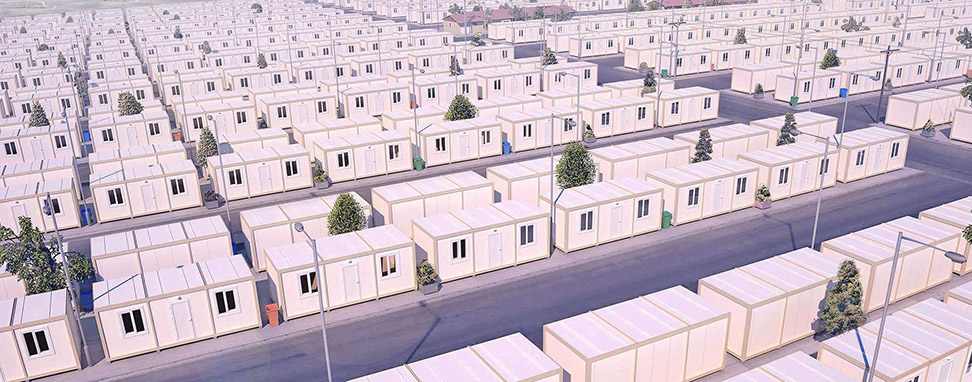With the rapid development of urbanization and the increasing demand for sustainable buildings, metal container houses are rapidly emerging around the world as an innovative building solution. They not only meet people's demand for low-cost and fast construction, but also provide stylish appearance and environmentally friendly options.
Metal container houses were originally transformed from shipping containers. Shipping containers are widely used for global cargo transportation. They are usually made of steel or aluminum and have the characteristics of durability, waterproofness and fire resistance. After the end of their transportation service life, many containers are idle or even abandoned, which provides opportunities for their reuse. Architects have transformed these abandoned containers into houses for residential or commercial purposes through innovative designs, which not only reduces material waste but also gives new life to the buildings.
Container houses are usually built in a modular form, that is, one or more container modules are combined into a house. This modular design can be easily combined and disassembled to meet different scenarios and functional requirements. At the same time, modular container houses can be easily transported and reassembled, and have strong flexibility.

Although the appearance of metal containers is unified, they can be designed and decorated in a variety of ways through cutting, splicing, painting, and adding glass windows. Architects can design stylish and unique appearances according to customer needs, making container houses not only practical but also beautiful.
The container itself is designed for long-distance transportation and adverse weather conditions, and has extremely high structural strength and durability. After proper modification and insulation treatment, container houses can provide a safe and comfortable living environment, and the wind and water resistance is also much higher than traditional wooden houses.
Compared with traditional construction methods, the construction cost of container houses is significantly reduced. Because the container itself can be reused, there is no need to build the building frame from scratch. In addition, its modular design also makes the construction process faster, saving manpower and time costs.
Metal container houses use waste shipping containers, reducing material waste and dependence on new resources. In addition, container houses have less impact on the environment during construction, and the construction process generates less construction waste and noise pollution. For people who advocate green environmental protection concepts, container houses are undoubtedly an ideal choice.
Due to the modular characteristics of containers, they can be quickly built and are suitable for emergency housing, temporary offices or construction needs in remote areas. In addition, container houses are highly adaptable and can be easily built on various terrains, including mountains, deserts and even water surfaces, with only corresponding infrastructure support.
Container houses have attracted the love of many young people and designers because of their unique design and personalized appearance. It can not only be used as a modern residence, but also as an art studio, cafe, retail store and other purposes, realizing the versatility of the building.
Although container houses have many advantages, there are also some challenges in practical applications:
Metal containers are prone to unstable internal temperature in an environment with large temperature changes, overheating in summer and cold in winter. Therefore, when building container houses, it is necessary to strengthen insulation and heat insulation measures, such as using insulation materials, installing air conditioning and ventilation systems, etc.
The metal material of the container is susceptible to moisture and corrosion, especially in coastal areas. Therefore, when building container houses, anti-rust and anti-corrosion treatment is required to extend its service life.
Although container houses are becoming more and more popular in many countries, in some areas, local government building regulations and planning regulations may restrict the construction of container houses. Therefore, before choosing to build a container house, it is necessary to ensure that it complies with local laws and regulations.
With the increasing attention to environmental protection and sustainable development, as well as the continuous advancement of construction technology, metal container houses have great potential for future development. Here are some possible development trends:
Future container houses may integrate green technologies such as solar panels, wind power systems, and rainwater collection to improve energy self-sufficiency and environmental friendliness. This will make container houses more suitable for use in remote or resource-poor areas.
With the popularization of smart home technology, container houses will increasingly integrate smart lighting, security, constant temperature control and other systems to improve living comfort and convenience. Future container houses will not only be residences, but also highly automated living spaces.
In addition to residential use, the application of container houses in the commercial field is also expanding. For example, many cities have begun to use container structures to build temporary exhibition halls, mobile restaurants, pop-up stores, etc. The flexibility and low cost of container houses make them an ideal choice for various commercial occasions.
As a new form of construction, metal container houses have been widely used around the world due to their low cost, environmental protection, and rapid construction. Despite some challenges, such as insulation problems and regulatory restrictions, with the advancement of technology and the growth of market demand, the future development prospects of container houses are still broad. It not only provides people with new living options, but also provides an innovative solution to housing problems and environmental protection in the process of urbanization. In the future, metal container houses will continue to develop in the direction of diversification, intelligence and greening, and become an important part of modern architecture.








